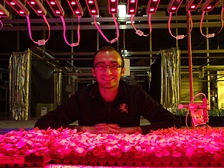
Features
Efficiency
Energy
LED research results expected end of 2012
July 6, 2012 By Treena Hein
 Several US universities are involved with an LED lighting project (photo courtesy Philips website).
Several US universities are involved with an LED lighting project (photo courtesy Philips website). How much can the use of LED lights increase greenhouse yields and decrease producers’ energy costs? Several US universities are involved in research on high-wire tomatoes and ornamental plants that will produce answers to this question by end of 2012.
Purdue University started in 2010 with a four-year United States Department of Agriculture (USDA) Specialty Crops Research Initiative grant to improve and evaluate LED lighting for greenhouse use (a project entitled ‘Developing LED Lighting Technology and Practices for Sustainable Specialty-Crop Production’).
A press release states that Purdue researchers will collaborate with Rutgers University, the University of Arizona, Michigan State University, Philips and Orbitec Technologies Corp. “We believe that LED supplemental lighting with a high red and blue ratio will produce high-quality marketable plugs at an earlier date than HPS supplemental lighting, the current industry standard,” says project director Cary Mitchell, who is a Purdue professor of horticulture.
“The high-intensity discharge lamps used today are inefficient. When you have acres and acres of greenhouses with these lamps in them, it really adds up,” Mitchell said. “With LED lighting, we should be able to do as well or better with much less energy.”
The project will include testing LED lighting on high-wire tomatoes, which can grow taller than 20 feet. Traditional overhead lighting doesn’t reach the lower parts of many plants, and Mitchell believes that using LED lights on the sides of plants will increase photosynthesis and flowering, improving yield.
Philips’ LED lights will be used in the project. “Successful field tests with growers and breeders around the globe [have given us] an unparalleled knowledge of the growth effects of lighting on different crops throughout their growth cycle,” the company states on its website. “It’s allowed Philips to create a unique approach to lighting with specific ‘light recipes’ that can be tailored. A wide variety of crops can benefit from LED while it is possible now to grow in multilayer environments without any daylight.”
Professor Erik Runkle at Michigan State University will test flower initiation of ornamental crops with different colors of LEDs, as well as performing project outreach. This research project will compare young bedding plant growth and development under traditional high pressure sodium lamp lighting to different combinations of red and blue Philips LED lighting. The goal is to find a sustainable lighting strategy of producing high-quality young plants in the shortest amount of time that will benefit the commercial floriculture in a greenhouse industry in America by consuming less energy.
Read more here.
Print this page